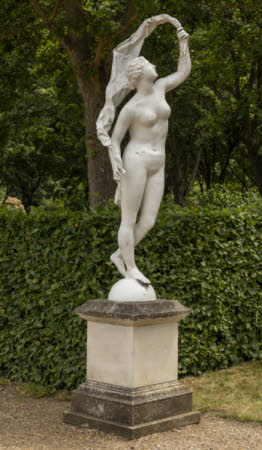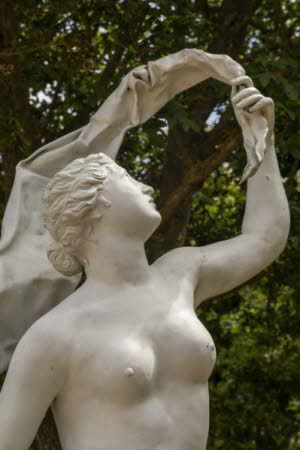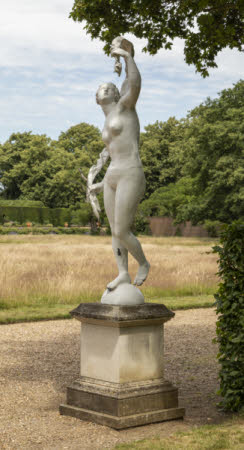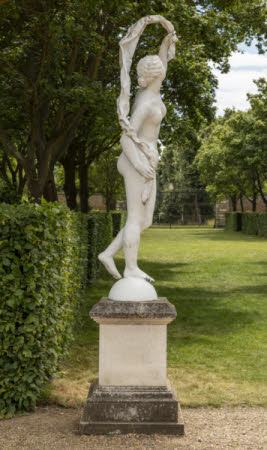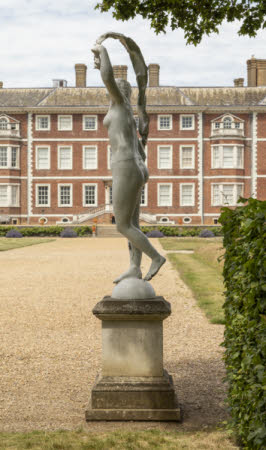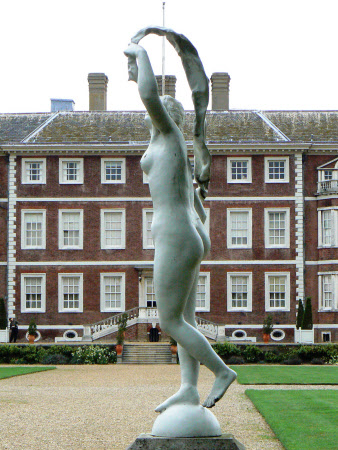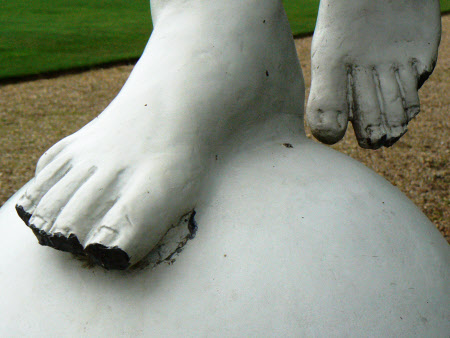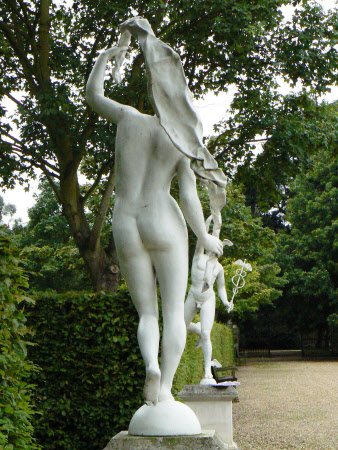Statue of Fortuna, goddess of chance
after Giambologna (Douai 1529 - Florence 1608)
Category
Art / Sculpture
Date
2003
Materials
Lead
Measurements
1800 mm (H)760 mm (W)450 mm (D)
Place of origin
London
Order this imageCollection
Ham House, Surrey
NT 1140391
Summary
A lead statue, painted white, depicting Fortuna, the Roman goddess of chance. She is depicted naked and balancing upon a half-sphere, holding a fluttering drape in both her hands. The statue, loosely based on a model by Giambologna (1529-1608), is a modern copy by Rupert Harris of a lead statue formerly in the gardens of Ham House.
Full description
A lead statue, painted white, depicting the Roman goddess of chance, Fortuna. She is depicted naked and balancing on her right foot upon a half-sphere, her body twisted to her left as she looks upwards, In her hands she holds a fluttering drape. Mounted upon a rectangular stone pedestal. One of two lead statues that were made in 2003 by Rupert Harris, to replace and evoke lost statues that are known to have been in the gardens at Ham House by the late 1670s. At this time the area of the gardens known as the Wilderness, to the south of the house, was embellished with a series of ten full-length lead statues of deities. A payment in 1672 recorded the installation of the sculptures, eight of which were ‘bronzed’ in 1673 and 1674, painted so that they appeared to be made of the more expensive metal bronze. Another two were painted white, to simulate marble, and perhaps also to create pleasing silhouettes against the brickwork of the house or the green hornbeam hedges of the Wilderness. The ten statues were recorded in the ‘Garden and Wildernesse’ of Ham House in the 1677 inventory as ‘Tenn statuas of lead whereof two upon stone pedestals, and Eight upon wooden pedestals.’ They may be seen in a painting attributed to Hendrick Danckerts and painted in the late 1670s, depicting the gardens to the south of the house ( NT 1139878). It would seem likely that the lead statues at Ham were made, like almost all the sculpture at Ham, in the workshop of the Besnier family, of French origin. John Besnier received a commission for lead statuary, including four full-length figures, from the Duke of Ormonde in 1681. The ten statues had all disappeared from Ham by the twentieth century. Copies of the two white-painted lead statues were commissioned in 2002, using the images in Danckerts’ painting as the starting points. Both statues were loosely based upon models by Giambologna (1529-1608), the Fortuna an assemblage that also used waxes from moulds of two bronze statues by Hubert Le Sueur (c. 1580-1658), Cleopatra and Diana, at Hampton Court Palace (information from Rupert Harris). Giambologna’s figure of Fortune was conceived as a pair to one of his most famous models, the Mercury, the subject of the other copy at Ham. It is known through a number of small bronze versions (Charles Avery and Anthony Radcliffe, eds., Giambologna 1529-1608. Sculptor to the Medici, exh. cat., Edinburgh/London 1978, nos. 13-16). An example of the Fortuna was in the collections of King Charles I before the Civil War, one of fifteen small bronzes after models by Giambologna and Pietro Tacca, presented by the Grand Duke of Tuscany to Charles’s elder brother Henry, Prince of Wales in 1612, a few months before his early death (Katharine Watson and Charles Avery, ‘Medici and Stuart: A Grand Ducal Gift of 'Giovanni Bologna' Bronzes for Henry Prince of Wales (1612)’, The Burlington Magazine, Vol. 115 (August 1973), pp. 493-507).Jeremy WarrenJanuary 2022
Provenance
Commissioned by the National Trust in 2003.
Makers and roles
after Giambologna (Douai 1529 - Florence 1608), model after John Besnier (fl.1681), sculptor after Hubert Le Sueur (c.1580 - Paris 1658), sculptor Rupert Harris Conservation Ltd, sculptor
References
Avery 2013: Charles Avery, ‘Seventeenth-century Sculpture at Ham House’ in Christopher Rowell, ed., Ham House. 400 Years of History, New Haven/London 2013, pp. 158-77., pp. 170-72.


